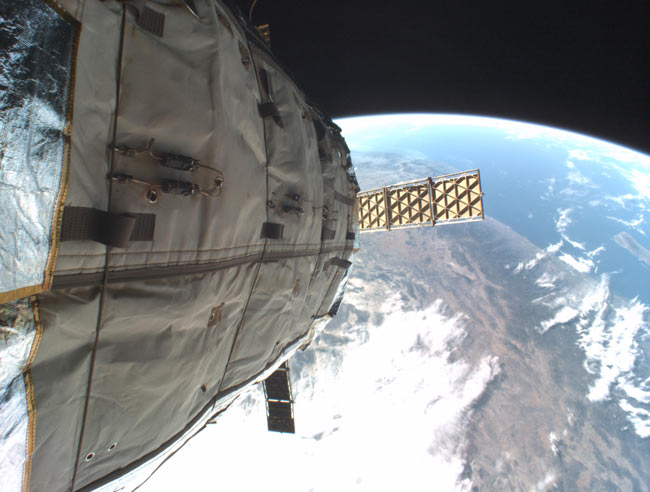Private Space Station Prototype Hits Orbital Milestone

A prototypemodule for a private space station has passed an orbital milestone aftercompleting its 10,000th trip around the Earth.
Genesis 1,an inflatablemodule built by the Las Vegas, Nev.-based firm Bigelow Aerospace, passedthe 10,000-orbit mark as it nears the beginning of its third year of unmannedoperations, its builders announced late Thursday.
BigelowAerospace launchedGenesis 1 atop a converted intercontinental ballistic missile on July 12,2006 to test its ability to self-inflate and operate in Earth orbit.
Now, more660 days later, the spacecraft?s exterior cameras have taken some 14,000 imagesthat include snapshots of all seven of Earth?s continents. Its solar panelshave also continuously powered electrical systems for about 15,840 hours,Bigelow Aerospace officials said.
Led by businessmanRobert Bigelow, owner of the Budget Suites of America hotel chain and otherenterprises, Bigelow Aerospace followed Genesis 1 with a successor, Genesis 2,in June 2007. That module also continues to function as designed.
With a lengthof about 14 feet (4.4 meters) and a diameter of 8 feet (2.5 meters), theGenesis modules are one-third scale versions of Bigelow Aerospace?s plannedBA-330 modules for manned missions.
?Since itwas lifted into orbit, Genesis 1 has continued to perform its main mission totest and verify systems to be used in futuremanned space habitats,? Bigelow Aerospace officials said in a statement. ?Genesis 1 has traveled the equivalent of more than 270million miles, which would take it to the Moon and back 1,154 times.?
Get the Space.com Newsletter
Breaking space news, the latest updates on rocket launches, skywatching events and more!
BigelowAerospace hopes to begin assembling its first crewed station using its Sundancermodule in about 2011.
While10,000 orbits is a major milestone, Genesis 1 has a long road ahead if it wantsto catch up to the International Space Station, which is currently manned by acrew of two Russian cosmonauts and one U.S. astronaut as it circles the Earth.NASA and its international partners plan to launch the lab?s largestlaboratory, Japan?s Kibo module, later this month.
TheISS celebrates its 10th anniversary this year and its oldest component -Russia?s Zarya control module - surpassed the 50,000-orbit mark in August 2007to complete what was then a 1.3 billion-mile (2.3 billion-kilometer) trek.When fully assembled in 2010, the ISS is expected rival a U.S. football fieldin length, include enough living space as a five-bedroom home and carry a crewof six astronauts.
- VIDEO: Robert Bigelow: Lessons, Visions and Realities of Commercial Space
- VIDEO: More on Bigelow Aerospace's Inflatable Modules
- Future of Flight: Space Tourism, Investment and Technology
Join our Space Forums to keep talking space on the latest missions, night sky and more! And if you have a news tip, correction or comment, let us know at: community@space.com.

Tariq is the Editor-in-Chief of Space.com and joined the team in 2001, first as an intern and staff writer, and later as an editor. He covers human spaceflight, exploration and space science, as well as skywatching and entertainment. He became Space.com's Managing Editor in 2009 and Editor-in-Chief in 2019. Before joining Space.com, Tariq was a staff reporter for The Los Angeles Times covering education and city beats in La Habra, Fullerton and Huntington Beach. In October 2022, Tariq received the Harry Kolcum Award for excellence in space reporting from the National Space Club Florida Committee. He is also an Eagle Scout (yes, he has the Space Exploration merit badge) and went to Space Camp four times as a kid and a fifth time as an adult. He has journalism degrees from the University of Southern California and New York University. You can find Tariq at Space.com and as the co-host to the This Week In Space podcast with space historian Rod Pyle on the TWiT network. To see his latest project, you can follow Tariq on Twitter @tariqjmalik.









